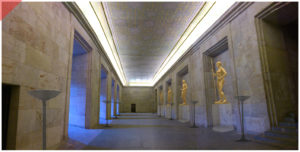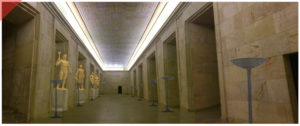We reveale one of the last secrets of the “Zeppelin grandstand”:
In the last decades there have been repeatedly false informations and incorrect assumptions about the planned figurine in the “Golden Hall” (Arno Breker was never intended as an artist here).
So; we make our contribution to bring light into this fog.
In the “Golden Hall” of the central tract of the “Zeppelin Field Grandstand” it was planned until the “Reichsparteitag 1939” to erect four golden gilded (bronze) sculptures by artist Kurt Schmid-Ehmen.
—

In a cross-fade, we show the niche front of the “Golden Hall” (as of July 2017) with the planned figures (height and width, shape of the base). The black and white image source with this information comes from 1936.
In addition to the figures, the erection of “(fire)” shells was planned. Open flames are probably can be excluded because of the soot development in the hall. Possibly. the shells were only optical ornamentation – without any lighting function.
 Here comes a panorama view with the four gilded bronze sculptures.
Here comes a panorama view with the four gilded bronze sculptures.
In the first picture (at the top), the outline of the planned figures can be seen. On the basis of the individual body holdings, we believe that we can assign the correct gold figure (from left to right):
1. The “torch bearer”: “Victory” (Sieg)
2. The “sword-bearer”: “Fight” (Kampf)
3. The “twig”: the former name “Honor” (Ehrung)
4. The “Speerträgerin”: “Faith” (Glaube)
The figures “faith” and “honor” were cast (in a reduced scale?) In bronze. The two males existed only as plaster models – according to our current knowledge. In the “Great German Art Exhibitions” in Munich, all four figures were shown – either as bronze or as a bronze dummy (gypsum model with paint). Such cases should also have existed.

Another panorama view with the enlarged figures (about 2.9 m height).
We have a photograph showing that Kurt Schmid-Ehmen shows “tribute” (the second-hand artist) in modeling the figure. Starting from a fictitious body size of the artist of 1.7 m, we arrive at this figure to a size of about 2.9 m.
It can not therefore be ruled out that the figures in the “Golden Hall” would have gotten this size. Our basic data base dates from 1936. The figures were planned for September 1939. It would have been the first time if nothing would had changed in the original plans. Ultimately, everything was turned out bigger. We do not want to underline this possibility. The space in the spaceships would have been enough.


A panoramic view in the “Golden Hall” with the four Schmid-Ehmen figures on the side.
We have not invented anything here. All dimensions and heights are based on drawings and floor plans from the magazine of 1936.
The figures (from right to left): “Faith”, “Honor”, “Fight” and “Victory”.
We show the four figure bases white-transparent, because we currently have no information on the planned place of the stone – whether it is polished or natural.
Our size-information concerning the “Golden Hall”:
Length: 36.38 m, width: 9.19 m, max. Ceiling height (mosaic): approx. 8.46 m, max. Height of the stone walls (up to the light strip): approx. 7.38 m.
On this basis: height of the candlesticks: approx. 2.0 m, height of the figure base, 1.34 m, height of the figures: approx. 2.17 m (they were described several times in the literature as “bigger than man size”).


A panorama view right from the opponent axis. The figures “Victory” and “Fight” can be looked at more closely.
Open questions:
Informations about the color of the four figural bases are unfortunately missing (which stone, which region of its origin, polished or nature). That is why we show the sockets white-transparent.
